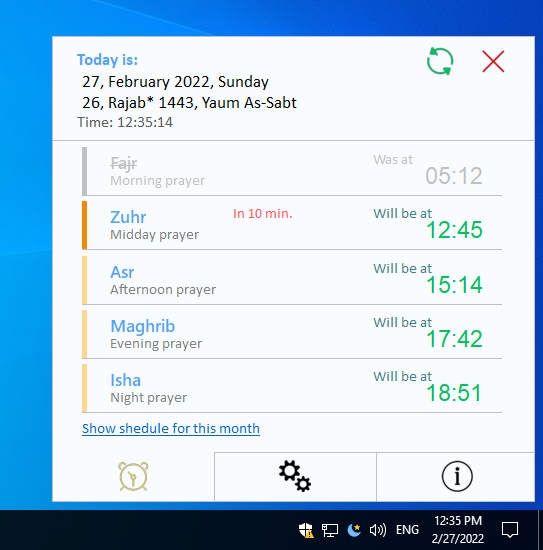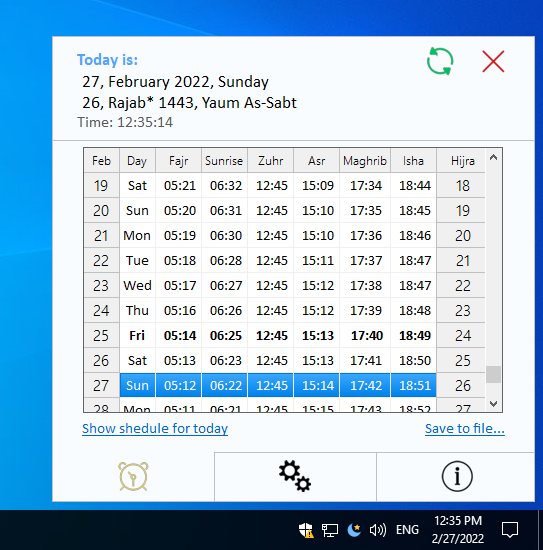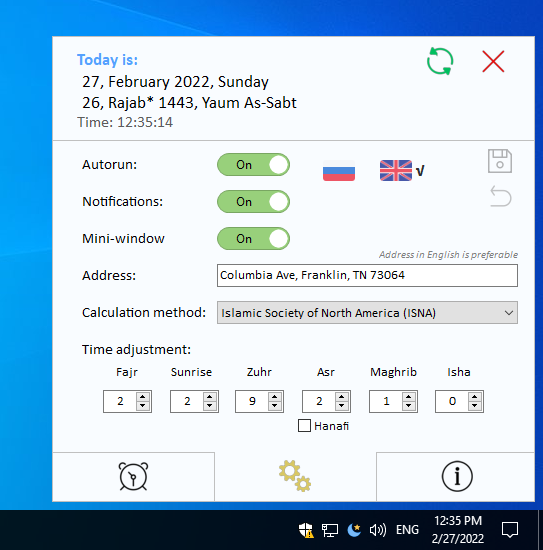Features
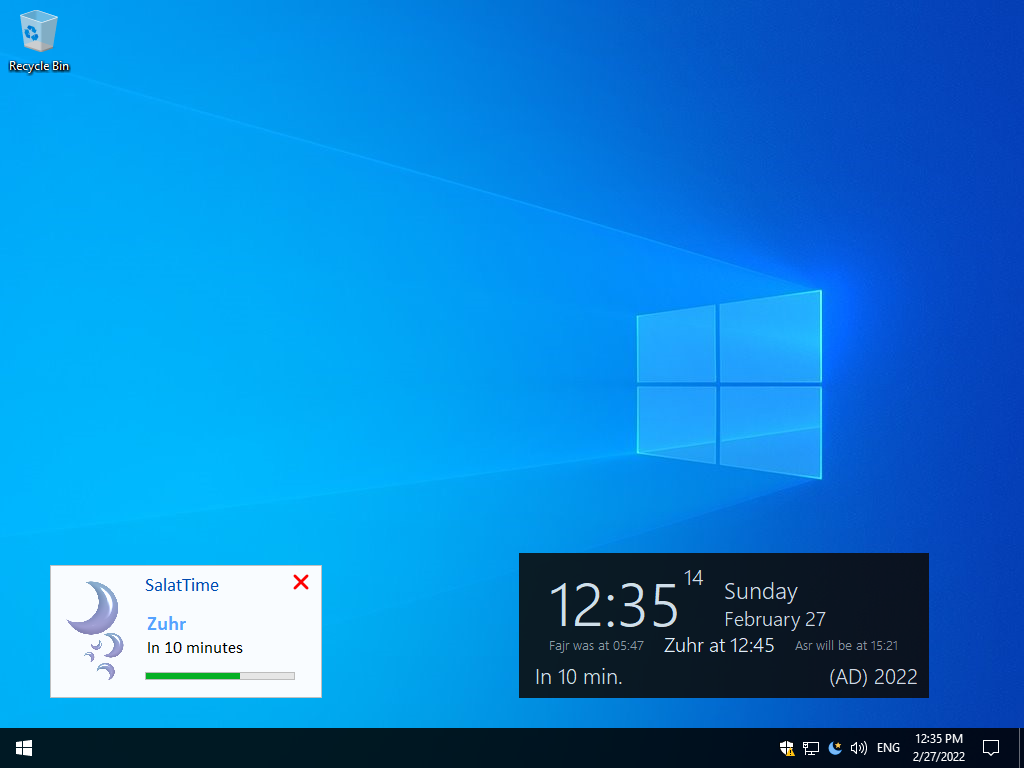
You have already forgotten, but the program still works
See the crescent moon in the tray? This is SalatTime!

If the icon is red - failed to get data from server
Maybe some work is underway, but better check the program settings and Internet connection.

If the icon is gray - notifications will not appear
Suddenly they interfered in full-screen applications, and you turned them off? Yes, there will be no sounds either.

Speaking of notifications
To turn them on or off, just right-click on the tray icon and select the appropriate item in the menu that appears.
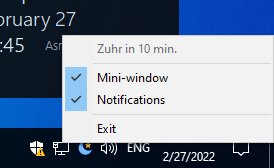
Now the main program window
Click on the tray icon with the left mouse button and the main window will appear.
There is a line with a date according to the Gregorian calendar, according to the lunar (hijra), current time, a list of prayers for today. In order not to distract attention, past prayers painted in gray. Months marked with an asterisk ("*") are sacred.
At the top, in addition to the close button, there is a refresh button, in case you think that the data is out of date.
At the bottom of the window there are three buttons for switching between tabs: schedule (with the alarm clock icon, current), settings (with gears) and information about the program (marked with "i").
To hide the window, click anywhere on the desktop or another program.
Schedule for the month
In the previous screenshot, under the tile of the last prayer, there is an inscription in the form of a link: "Show schedule for this month". When you click on it, you will see a table with a monthly schedule of prayers, a date for each day and highlighted jum`a days.
For convenience, today is already highlighted.
This schedule can be saved to a file (it will be saved as a notepad `.txt` file) and print.
It's time to configure the program
To begin, do not forget to add it to the startup!
The settings are intuitive: notifications, language, buttons for saving and resetting changes, settings for asr prayer (according to the Hanafi madhhab, the time for asr prayer starts from the moment when the object’s shadow is twice as large as the object itself), address (you can even enter coordinates), calculation method (in general, this setting only affects fajr and isha, so it’s difficult to choose something wrong here) and time adjustment (shift of prayer time by a specified number of minutes; values can range from -10 to 10).
If the program window loses focus and disappears, the changes will not be saved.
To miss a prayer is impossible!
Notifications appear on the left side of the desktop for 15, 10, 5 minutes and when the prayer time comes. The notification can be closed in advance, or it will close itself as soon as the timer strip reaches zero.
Notifications are accompanied by a short beep (it is pleasant), and after the timer expires, the last notification will play an azan (only a second, the first words). If you do not want the azan to be played, just close the notification.

All the most basic - in the tooltip
When you hover the mouse over the tray icon, a notification appears containing the time remaining until the next prayer, and reminders of the memorable dates, events and voluntary fasting.

Memorable dates and events
If an asterisk appears in the tray icon, hover over the icon to find out what the program reminds you of!
The list is shown below.

List of memorable dates and events:
- Trekking to Khaybar, 7 Muharram
- Day of Ashura, 10 Muharram
- Relocation Night, 27 Safar
- Birth of the Prophet (SAS), 12 Rabi Al-Awwal
- Night Ragaib, first night from thursday to friday of the month of Rajab
- Hijra to Ethiopia, 7 Rajab
- Night of the Ascension, 27 Rajab
- Night Baraat, 14 Sha`ban
The beginning of fasting, 1 Ramadan(the event is excluded so as not to confuse people in the event of a date mismatch in different regions)- Battle of Badr, 17 Ramadan
- Surrender of Mecca, 21 Ramadan
- Uraza Bayram (Eid al-Fitr), 1 Shawwal
- Battle of Uhud, 9 Shawwal
- Battle of Hunayn, 10 Shawwal
- Battle of the Pit, 12 Shawwal
- The Treaty of Khudaybiya, 6 Zul-Qaadah
- Day of Araf, 9 Zul-Hijjah
- Kurban Bayram (Eid al-Adha), 10 Zul-Hijjah
- At-Tashrik days - three days after the sacrifice
List of voluntary fasting:
- 9, 10, 11 Muharram
- Birth of the Prophet (SAS), 12 Rabi Al-Awwal
- Day of Araf, 9 Zul-Hijjah
- Monday and thursday
- 13, 14 and 15 of each month
The list of days on which the voluntary fasting is excluded:
- Days of doubt (3 days before the start of Ramadan)
- Uraza Bayram (Eid al-Fitr), 1 Shawwal
- Kurban Bayram (Eid al-Adha), 10 Zul-Hijjah
- At-Tashrik days - three days after the sacrifice
- Ramadan


